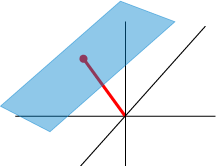Section1.1Portfolio 1
¶Portfolio 1: Solutions of Linear Systems is due to Blackboard by 11:59 p.m. Monday, June 4th.
Subsection1.1.1Purpose and Learning Standards
¶The goal of your first portfolio is to show that you've developed the foundational algebraic skills you'll rely upon all semester to solve systems of linear equations and to use careful mathematical terminology and notation to describe the nature of your solutions.
The learning standards included in this portfolio are:
- 1.A Solve systems of linear equations, written in equation form or augmented-matrix form, using row operations and Gaussian elimination.
- 1.B Characterize the solution set of a system of linear equations using appropriate notation and vocabulary, distinguishing consistent systems from inconsistent.
- 1.C Identify the pivots in a system of linear equations and discuss their effects on the nature of the system's solution set.
- 1.X Understand precise mathematical definitions in order to determine whether a given object satisfies them or not.
Subsection1.1.2Skills You'll Develop
¶In this portfolio you'll gain practice with the following skills that will not only promote your success in linear algebra, but grow as practitioners of pure and applied mathematics.
- Understand and strategically apply elementary row operations to simplify a system of linear equations and discover its solution set.
- Identify the row-echelon and reduced row-echelon form of a linear system.
- Use set-builder notation and a sketch of lines/planes to accurately and insightfully describe the solution set of a linear system.
- Write clear, concise discussions of precise mathematical definitions, including definitions including quantifiers ("for all," "there exists").
Subsection1.1.3Knowledge You'll Gain
¶In this portfolio you'll gain familiarity with the following important content knowledge of linear algebra.
- Linear equations (as distinguished from nonlinear).
- Elementary row operations.
- Gaussian elimination.
- Echelon forms.
- Pivots (and pivot rows and pivot columns).
- Consistent and inconsistent systems.
- Set-builder notation.
- Logical quantifiers and elementary proof/counter-proof arguments.
Subsection1.1.4Tasks
¶You'll demonstrate that you've fulfilled the purpose of this assignment by completing the following sets of tasks. Each type of task will generate an artifact that you can include in your portfolio.
- Begin your Learning Narrative 1 (click here for more information)
- Engage regularly with your classmates through reading discussions, Flipgrid assignments, Piazza discussions, and/or online gatherings.
- Practice problem solving in WeBWoRK (click here to access)
- Submit, and revise based on feedback, quizzes and exams via Blackboard (click here to access)
- Type up, and revise based on feedback, solutions to a selection of proof exercises via Blackboard (click here to access)
- When finished with the above, complete your Learning Narrative 1 (click here 3 for more information).
- Finally, submit your finished portfolio by the due date via Blackboard (click here to access).
Subsection1.1.5Criteria for Success
¶Your portfolios in this course are the primary component on which you are graded. Accordingly, your portfolio must contain evidence that you have done each of the following:
- Met each computational learning standard listed above (1.A, 1.B, 1.C). For each standard, evidence must include one or more quizzes, exam problems, and/or copies of fully worked-out sets of WeBWoRK exercises related to these standards.
- Met each conceptual learning standard listed above (1.X). Evidence must include your typeset proof portfolio problems (as a PDF).
- Engaged with your classmates around coursework. Evidence must include screenshots or printouts of one or more discussions within reading annotations or on Piazza, and/or a discussion of your contributions to video boards or online hangouts.
- Reflected on the progress of your own learning. Evidence must include your Learning Narrative at the front of your portfolio, which explicitly references how the other evidence in your portfolio supports your having done all of the above.
Subsection1.1.6Example Contents
¶The main components of your portfolio are only two: Narrative and Artifacts. Imagining that you're a lawyer who must make a case that you've met the learning standards, engaged with your classmates, and reflected on your progress, the narrative is like your opening statement and the artifacts are your evidence.
For instance, the contents of your portfolio might include:
- Narrative: Word document/PDF including my pre-portfolio reflection, followed by 1-2 reflective paragraphs in which I explain why each of the following artifacts supports my case.
- Artifact 1: Copy of my Quiz 1 showing evidence I've mastered Learning Standard 1.A
- Artifact 2: Copy of my Quiz 1R showing evidence I've mastered Learning Standard 1.B
- Artifact 3: Copy of my Quiz 2 on which I didn't quite master Learning Standard 1.C
- Artifact 4: A collection of fully-worked-out WeBWoRK problems showing further evidence that I mastered Learning Standard 1.C
- Artifact 5: Copy of my Proof Portfolio showing evidence I've mastered Learning standard 1.X
- Artifact 6: Screenshot of a Piazza discussion which I feel best demonstrates how I've engaged with my classmates in this portfolio to support one another's learning
Remember, any learning standard you don't yet meet in Portfolio 1 you'll have more chances to meet throughout the semester - including but not limited to the final exam (Portfolio 5). The proof portfolio in particular will be iteratively revised and improved throughout the whole course, with an updated copy submitted with each portfolio.
